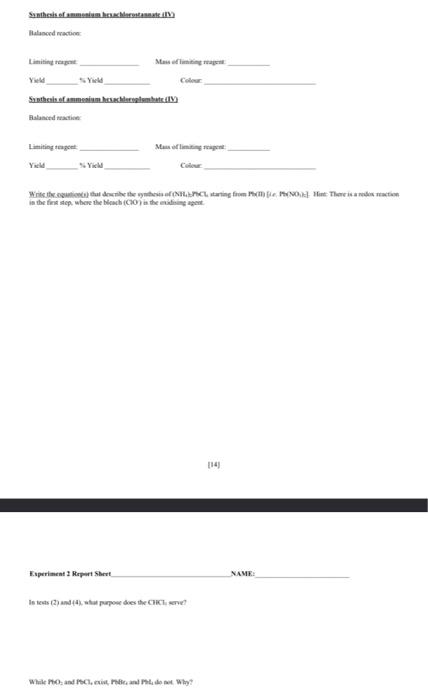
please answer these following questions.

Experiment Two: The Inert Pair Effect: Relative Stabilities of Tin(IV) and Lead(IV) Purpose of the Experiment In this experiment, the student will examine the redox, acid base, and solubilly chemistry, as well as the relative stabilities of the +2 and cidation states of fin and lead 121 Introduction The elements of Group 14 are characterized by an electronic configuration. Thus, the members of this group often use their four valence elections to form four O-bonds. The heavier members of the Group (heavier than carbon) are also capable of achieving higher coordination numbers (ieska-coordinate) by using their dorbitals. In generalthe elements of this group are often described by a 4 condation state when bound to atoms of greater electronegativity log halides). However, as one proceeds down the group, the stability of the oxidation state decreases and, in fact, there is a greater tendency to form compounds possessing a #2 oxidation state for the heaviest elements. Thus, the inner shell electrons of the heavier elements are often not used in bonding that is to say they act as an inert pair of electrons. In general this phenomenon is referred to as the inert par effect and it is also observed in other heaver man group nuclei such as Thallium (41 vs. +3). Sead (+2 vs. 14), and bismuth (43 vs. +5, where the lower charged ions are more stable than the more highly charged ons Load/IV) is generally only stable when bonded to highly electronegative ligands (e.g.) and Pb(IV), is easily reduced to Pell). For in, the +2 and 4 oxidation states have similar stabilities. In this experiment, the student will have the opportunity to prepare Sn[V) and Pb(IV) complexes in the form of (NH), MCL (M = Sn or Pb), and observe firsthand the relative stabilities of each. A number of qualitative tests will be conducted in order to compare the stability of the +2 and condation states of tin and lead, as well as examine some redox chemistry of each element Experimental Procedures Special Notes and Safety Precautions A number of reagents are used in each proparation which require special attention. Snc fames in open air; the fumes are very corrosive and must never be inhaled The T.A. will dispense this reagent for the student in the fumebood! The lead roagent used in this experiment, PWNO and its products are all prison. Any skin contact with these materials must be wided. Gloves can be worn when manipulating these materials Flush all areas with copious amounts of water where contact has been made. In several preparations concentrated acids and buses are used. Care must be exercised when using these solutions and all exposed areas must immediately be flushed with water Synthesis of Ammoniw Hexachlorostuninate/1). (NW.SC. In the fumebood, add a volume of saturated NIII solution (5 mil.) to a clean, dry 10 ml beaker, and then slowly and controly 1.8 ml of Salt to the solution, with stirring (glass rodi Once the mixture stop fuming. cool the mixture in ice until crystals of (NH.SC. begin to deposit. Filter the crystals (Bchner) and allow them to dry in the air do not wash the crystals with water as they are quite soluble, if necessary, use ice cold water). Record the yield and set the product aside for the qualitative tests to follow. Synthesis of Ammonium Hexachlorplumbare), NH.;PCI, (a) Synthesis of Pho: from Ph. Prior to pecparing the title complex, Pho: must be pecpared. In a 250 ml beaker, add Pb(NO2(about accurately weighed and dissolve it in water (25 m.). Next, prepare a solution of NaOH fag) by dissolving NaOH (10 g) in a separate 150 ml. beaker with water (50 ml.). Add the solution of NaOH to the 250 ml.beaker with stirring and corfully boil the mixture for 5-10 minutes on a hotplate. Next, while continuously stiming the hot mixture, sely add a solution of NaOCI (20 mL of a 5% 131 solutions for the artisanar tart us (unrtant stories turmer attinies at the MARI The deep dark brown black precipitate that forms is this should form after 5-10 minutes) Filter the solution bot (Buchner, wash the product with water 310 m, followed by dilute HNO. 5 ml of a 2 solution, and then again with water (10 ml) The Po does not have to be dry for the next stage of the reaction. Also, it may be stored in the locker til needed in either can set and a small portion about g is enough of the Profor me in the qualitative tests Synthesis off. It is imperative that the following reactions be performed in ke cold. In a 50 ml.beaker adida volume of wated Nutie Omland in a 10 ml.boker add concentrated car HC (5 ml.) Cool both solutions thoroughly ince With the beaker containing the HII still in the ice bath, slowly add mo (prepared above) with constant stirringredik a yellow solutie should be obtained in some challmount of white precipitate will appes at this stage this does not influence the outcome of the reactie, however its appearance and keep it in mind when conducting the tests that follow In the event that some white precipitate does appear after deling all of the Pho leave the yellow solution in the see but for a few minutes so as to allow to citle Next quickly but carefully decant the yellow solution into the ice-cold Notice still in the ice but with sing, making sure to leave hehind any white solid that may have previously appeared. Allow the mixture to sit in the ice but for several minutes in order to complete the precipitation, the filter the NPC. product Bichner) from the mixture Do not wash the product with water as it is very soluble in this solvent. Allow the product to air dry they may be stored in the locker until the next laboratory senion) and record the yield Qualitative Analysis of Tinand Land Perform the following qualitative tests and record ALL observations, the prepared to observe NO reaction in (1) Place a portion of each ammonium in parte test tubes and add a line water. Carefully beat both solutions for several minutes in a hot water buth and beve, allowing each tube to sit in an ice both after heating will assist in making any observation Place a part of each monium in punte testube and little watet. To cach tube add CHCH. (ml) followed by 5-10 drops of K solicidified with a few drops of Glue H.SO Supper and shake both tubes, and observe (3) Make solution of Snill and Path as follow dissolve 2 SC1,021,0 a HC (10 m. of a 0.1 At solution centrifuge and use the solution dove NO in water (10 m.) perform the following: To small portions about 1 ml) of each in individual to be ad a few drops of Me oli tutube acidified with a few drops of dilute (2) H.SO and observe To all portion of the Part solution in a test tube add a couple of drops of concentrated (car) HCl and observe. Similarly but with a froh sample add a few dropsel Kllution and observe m) To small portions of each solution in individu test tubes add a few drops of No:50. solution and one To a small price of the South solution in a few tube, Howly add HCM) dropwise with mixing until no further changes are observed. Observe the changes (4) In two separate testes place mul volume about 1 m.) of Klincidified with a few drops of dilute (2 MH.SO. followed by CHCI (about 1 ml). Next, add a mallment of Po, to tube and S, to the other stopper each tube and shake. Note tyre In two separate te mbes, disolve a few crus(this is all that is required, any more than this and the reaction may be difficult to observe) of Meso, in dilute (2M) HINO, (a few is all that is required) Toone tube add some solido, the other Sr. Carefully boileach misture and observe the reads (5) Samthesis of ammonium. Beachterstated Balanced at Mowe Santhesis of ammonium hexachlorogenbute IV Balanced Writeettien taldetike the whole (NEDC tarting from Nine There is a modern tection in the first step, where the beach in the image 114 Experiment Reportshert NAME: In tests (3) and 44, he purpose des the CHCI Core Whileno, and 1. Why

 please answer these following questions.
please answer these following questions.






